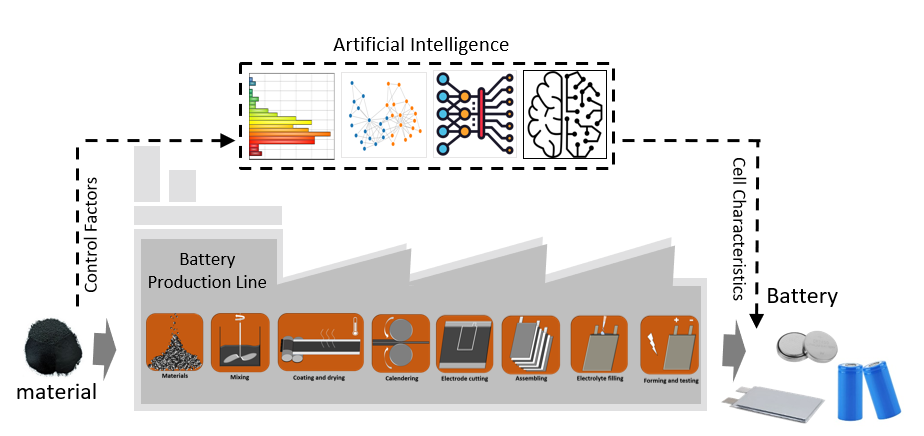FST BLOG
What is the Role of Artificial Intelligence in Lithium-ion Battery Manufacturing During the Transition to NetZero?
- 7 March 2023
- Environment, Technology
- Mona Faraji Niri

.png?lang=en-GB)
Lithium-ion Battery Role
The transition to NetZero is a hot topic, expected to happen in the UK some time before 2050. The electrification of transportation system is highlighted as the main contributor to Carbon emissions in the UK, with a share of 27% of CO2 in 2019 according to the UK Department for Business, Energy & Industrial Strategy. This is just related to the transportation vehicles themselves, leaving aside the emissions from sources within the sector, such as manufacturing of the vehicles or fuel production.
Electrification of transportation systems means reducing this contribution but it is not possible without clean, affordable and efficient energy storage systems. This is why lithium-ion batteries (LiBs) have found their way into most vehicles. LiBs have high energy density, reasonable lifetime, acceptable safety and controllability.
In the last thirty years, their energy density has increased by more than 3 times and their manufacturing price has dropped by more than 45 times. But questions remain: is this enough to power all vehicles? Can this respond to the increasing demand from newer sectors, not only for passenger vehicles, but also for airplanes and micro-mobility vehicles such as e-bikes, e-scooters, and e-motorcycles? According to the Faraday Institution, this demand is expected to be between 60-90 GWh by 2035. With the UK’s total LiB production capacity of 2.3 GWh in 2018 according to Faraday Institution and 4 GWh in 2021 according to the UK Battery Industrialisation Centre, there is still a long way to go. This requires a strong battery manufacturing industry to meet the demand.
Battery Manufacturing
.png?lang=en-GB&width=800&height=394) Manufacturing Process of Lithium-ion batteries (Credit of Image: SIMBA Project, WMG, University of Warwick)
Manufacturing Process of Lithium-ion batteries (Credit of Image: SIMBA Project, WMG, University of Warwick)
Lithium-ion battery manufacturing is a long process consisting of various steps of formulation and material selection, mixing, coating the slurry on the current collectors (usually Copper and Aluminium) and forming the electrodes, drying to evaporate the coating’s extra solvents, and calendering or pressing the electrodes to reduce the porosity and increase the density. The process continues by cutting the electrodes according to the shape of the cell (coin, cylindrical, pouch or prismatic) followed by cell assembly, including the stacking of layers, tap welding, packaging and finally testing. Such a process has more than 600 control factors and design variables, for example the temperature of the dryer and speed of the coating machine. But how are these parameters selected?
One might say: “set most variables to fixed values and change the interest variables to see the impact on the cell characteristics”. Although this might seem like a solution, it is not at all practical. It comes with questions. What values should the variables be? What should the range of the response variable be? How should we break down the range to levels to run the experiments? How do we know if all those values will end up with a cell good enough to be used? Will it make a slurry with a viscosity suitable for coating? Will the coated electrode be crack free for proceeding to the stacking and packaging? What if manufacture decides to change one of the materials or formulation – would that mean starting again? And these are all beside the fact that we are dealing with billions of billion possibilities when discussing the reality of all 600 factors!
The Role of AI
All the questions mentioned above regarding the R&D of LiBs cells require a systematic approach to answer. It is here that we need Artificial Intelligence (AI) technologies to intervene, support and improve the manufacturing processes. We need to increase the efficiency of production lines and reduce material waste during research and development. Whilst artificial intelligence refers to a very wide range of methods and approaches, in this case, Machine Learning is the most relevant.
Recent research shows the application of AI in battery manufacturing. ‘Digital twinning’ of the manufacturing process can significantly improve the control procedure and the resulting battery quality. It helps create links between the highly non-linear and interconnected process variables and cell characteristics, such as energy density, energy capacity, lifetime and stability. These links can be interpretated as models (or ‘digital twins’) for manufacturing stages and can help provide recommendations towards improving large-scale manufacturing. The models need good quality data in order predict cell characteristics for the selection and combination of variables where no experimental data is available. This data is collected via design-of-experiments and, unlike the previous approach (change-one-variable-at-a-time), it can be based upon multiple variable changes in a single record of data. This is because Machine Learning will be able to separate the factor effects statistically and mathematically.
Machine Learning-based battery manufacturing models mean that the characteristics of cells can be predicted by calculations – without getting any hands dirty. This is important to reducing the waste of material. However, like any other emerging technology, it has its own challenges. Access to good quality data; transferability of models from one material and formulation to another; and generalisability of models from lab to pilot to large scale are among the most significant problems yet to be investigated. This is why considerable funds are dedicated to this sector, such as the Faraday Institution’s £12m 5-year UK project: LiB Electrode Manufacturing Process Optimisation of NEXTRODE.
